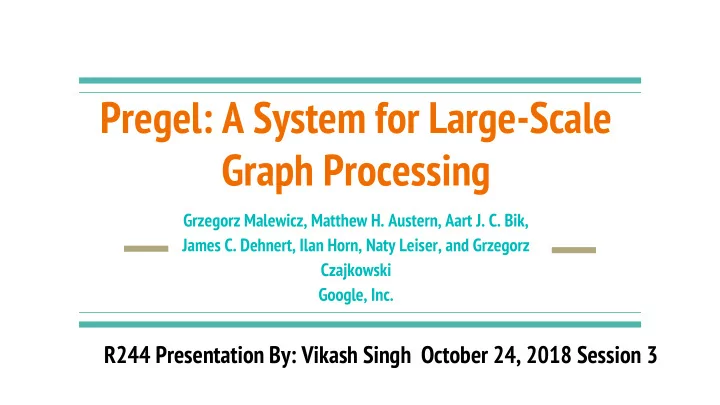

Pregel: A System for Large-Scale Graph Processing Grzegorz Malewicz, Matthew H. Austern, Aart J. C. Bik, James C. Dehnert, Ilan Horn, Naty Leiser, and Grzegorz Czajkowski Google, Inc. R244 Presentation By: Vikash Singh October 24, 2018 Session 3
What is Pregel? ● General purpose system for flexible graph processing ● Efficient, scalable, and fault-tolerant implementation in a large-scale distributed environment
Bulk Synchronous Parallel Model (BSP) [1]
Pros and Cons of BSP for Distributed Graph Processing ● Pro: Naturally suited for distributed implementation Order does NOT matter within a superstep ○ All communication is BETWEEN supersteps ○ ● Pro: No deadlocks or data races to worry about ● Pro: Capable of balancing the load to minimize latency ● Con: As this scales to potentially millions of cores, barriers become expensive!
Termination Mechanism
Key Decision: Message Passing vs. Shared Reads ● Message passing expressive enough, especially for graph algorithms ● Remote reads have a high latency ● Message passing can be done asynchronously in batches
Comparison to MapReduce ● Graph algorithms can be written as a series of chained MapReduce invocations ● MapReduce would require passing the entire state of the graph from one state to the next, more overhead and communication ● Complexity added that would be taken care of by convenient supersteps in BSP
C++ API Overview ● Vertex class, virtual Compute() function (aka the instructions for each superstep) ● Compute function flexible to change topology ● Combiners/Aggregators available ● Handlers
Master-Worker Architecture ● Master assigns partitions of vertices to workers ● Master coordinates supersteps and checkpoints (fault tolerance) ● Workers execute compute() functions for vertices and directly exchange messages with each other
Fault Tolerance ● Workers save state of partitions to persistent storage at checkpoint ● Ping messages to check worker availability ● Checkpoint frequency based on mean time to failure model ● Reassign partitions, revert to last checkpoint in failure instance
Master-Worker Implementation Master Worker Maintains list of all living workers (ID, Maintains the state of graph ● ● addressing, partition) partition in memory (vertex id, Coordinates supersteps through ● current value, outgoing messages, barrier synchronization/initiates queue for incoming messages, recovery in failure iterators to outgoing/incoming Maintains stats on the progress of ● messages, active flag) the graph, runs HTTP server that Optimizations present for vertex ● displays info message sending within same machine, or else use delivery buffer
How does Pregel Scale with Worker Tasks? Experiment Notes (General) ● 300 multicore commodity PCs ● Time for initializing cluster, generating the test graphs in memory, and verifying results not included ● Checkpointing was disabled
How does Pregel Scale with Graph Size (Binary Tree)?
How does Pregel Scale with Graph Size (Log Normal Random Graph)?
Criticism ● No legitimate effort to compare to other systems such as MapReduce [3] , Parallel BGL [4] ,CGMGraph [5] , Dryad [2] , ● No explanation of fault tolerance in case of failure of master ● Inefficient for imbalanced data (no dynamic repartitioning) PowerGraph to the rescue! ● Checkpointing disabled in experiments, fault tolerance not experimentally tested ● No experimental analysis of slow down from spill over of data to disk when RAM gets full
PowerGraph: Distributed Graph-Parallel Computation on Natural Graphs J. Gonzalez, Y. Low, H. Gu, D. Bickson, and C. Guestrin:
Digging into Pregel’s Load Imbalance Issue ● Natural graphs often have skewed power-law degree distribution, causes significant imbalance in a vertex-centric system such as Pregel ● Storage, computation, and communication issues ● No parallelization within each vertex
Visualizing Power-Law Degree Distribution
Powergraph Solution Distribute edges rather than vertices, allowing for parallelization of huge ● vertices (vertex-cut) Execution of vertex program, using Gather, Apply, Scatter (GAS) model ● Gather Apply Scatter Collect data from Perform operation on Spread information to neighbors and aggregated data neighbors and perform aggregation activate their operations
Vertex-Cut Communication
Runtime Comparison
Worker Imbalance and Communication Comparison
Final Thoughts ● Pregel mostly achieved its main goal: a flexible distributed framework for graph processing ● Weak experimental data and comparisons, however it is in production on multiple systems at Google so we have some degree of faith ● Powergraph solves issue of load imbalance in Pregel’s method of distributed graph processing
References 1. Leslie G. Valiant, A Bridging Model for Parallel Computation. Comm. ACM 33(8), 1990, 103–111. 2. Michael Isard, Mihai Budiu, Yuan Yu, Andrew Birrell, and Dennis Fetterly, Dryad: Distributed Data-Parallel Programs from Sequential Building Blocks. in Proc. European Conf. on Computer Syst., 2007, 59–72. 3. Jeffrey Dean and Sanjay Ghemawat, MapReduce: Simplified Data Processing on Large Clusters. in Proc. 6th USENIX Symp. on Operating Syst. Design and Impl., 2004, 137–150 4. Douglas Gregor and Andrew Lumsdaine, The Parallel BGL: A Generic Library for Distributed Graph Computations. Proc. of Parallel Object-Oriented Scientific Computing (POOSC), July 2005. 5. Albert Chan and Frank Dehne, CGMGRAPH/CGMLIB: Implementing and Testing CGM Graph Algorithms on PC Clusters and Shared Memory Machines. Intl. J. of High Performance Computing Applications 19(1), 2005, 81–97.
Recommend
More recommend